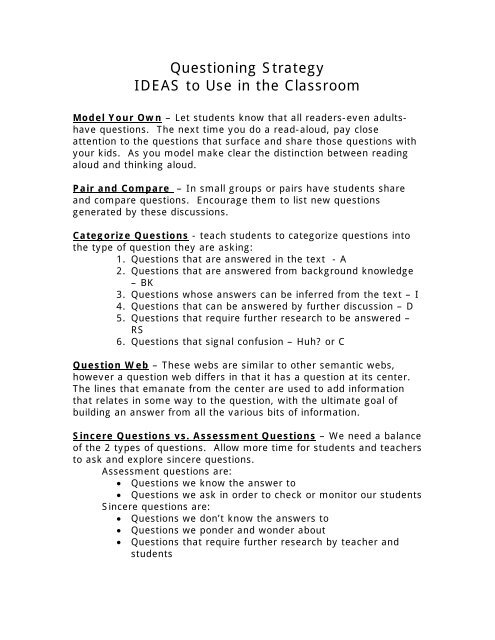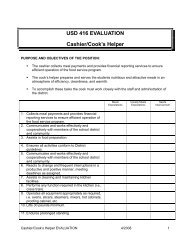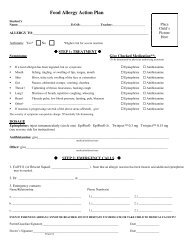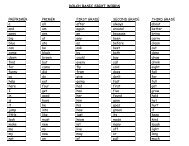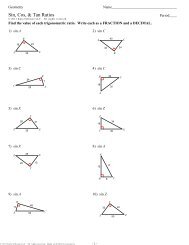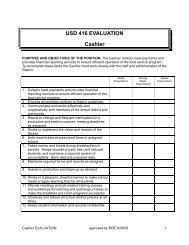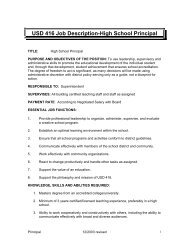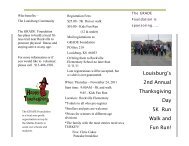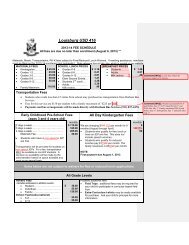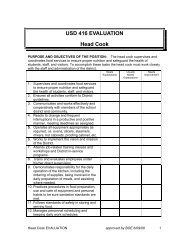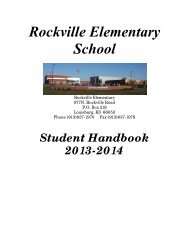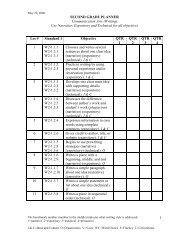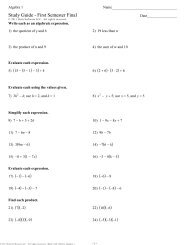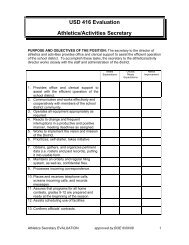Questioning Strategy IDEAS to Use in the Classroom
Questioning Strategy IDEAS to Use in the Classroom
Questioning Strategy IDEAS to Use in the Classroom
You also want an ePaper? Increase the reach of your titles
YUMPU automatically turns print PDFs into web optimized ePapers that Google loves.
<strong>Question<strong>in</strong>g</strong> <strong>Strategy</strong><strong>IDEAS</strong> <strong>to</strong> <strong>Use</strong> <strong>in</strong> <strong>the</strong> <strong>Classroom</strong>Model Your Own – Let students know that all readers-even adultshavequestions. The next time you do a read-aloud, pay closeattention <strong>to</strong> <strong>the</strong> questions that surface and share those questions withyour kids. As you model make clear <strong>the</strong> dist<strong>in</strong>ction between read<strong>in</strong>galoud and th<strong>in</strong>k<strong>in</strong>g aloud.Pair and Compare – In small groups or pairs have students shareand compare questions. Encourage <strong>the</strong>m <strong>to</strong> list new questionsgenerated by <strong>the</strong>se discussions.Categorize Questions - teach students <strong>to</strong> categorize questions <strong>in</strong><strong>to</strong><strong>the</strong> type of question <strong>the</strong>y are ask<strong>in</strong>g:1. Questions that are answered <strong>in</strong> <strong>the</strong> text - A2. Questions that are answered from background knowledge– BK3. Questions whose answers can be <strong>in</strong>ferred from <strong>the</strong> text – I4. Questions that can be answered by fur<strong>the</strong>r discussion – D5. Questions that require fur<strong>the</strong>r research <strong>to</strong> be answered –RS6. Questions that signal confusion – Huh? or CQuestion Web – These webs are similar <strong>to</strong> o<strong>the</strong>r semantic webs,however a question web differs <strong>in</strong> that it has a question at its center.The l<strong>in</strong>es that emanate from <strong>the</strong> center are used <strong>to</strong> add <strong>in</strong>formationthat relates <strong>in</strong> some way <strong>to</strong> <strong>the</strong> question, with <strong>the</strong> ultimate goal ofbuild<strong>in</strong>g an answer from all <strong>the</strong> various bits of <strong>in</strong>formation.S<strong>in</strong>cere Questions vs. Assessment Questions – We need a balanceof <strong>the</strong> 2 types of questions. Allow more time for students and teachers<strong>to</strong> ask and explore s<strong>in</strong>cere questions.Assessment questions are:• Questions we know <strong>the</strong> answer <strong>to</strong>• Questions we ask <strong>in</strong> order <strong>to</strong> check or moni<strong>to</strong>r our studentsS<strong>in</strong>cere questions are:• Questions we don’t know <strong>the</strong> answers <strong>to</strong>• Questions we ponder and wonder about• Questions that require fur<strong>the</strong>r research by teacher andstudents
Us<strong>in</strong>g Questions With Poetry – Unlock<strong>in</strong>g a poem’s mean<strong>in</strong>gthrough questions leads <strong>to</strong> <strong>in</strong>ferential th<strong>in</strong>k<strong>in</strong>g. The questionsserve as prompts <strong>to</strong> <strong>the</strong> <strong>in</strong>terpretation of <strong>the</strong> poem and <strong>the</strong> <strong>in</strong>ferencesabout its mean<strong>in</strong>g. There are no absolute answers when <strong>in</strong>terpret<strong>in</strong>gpoetry. Langs<strong>to</strong>n Hughes’s poem “Dreams” is a good example of apoem <strong>to</strong> <strong>in</strong>terpret through <strong>the</strong> use of questions.Thick and Th<strong>in</strong> Questions – Thick questions are those that addresslarge, universal concepts and often beg<strong>in</strong> with Why? How Come? Iwonder? Or <strong>the</strong>y address large content areas, such as What ispho<strong>to</strong>syn<strong>the</strong>sis?Th<strong>in</strong> questions are those primarily asked <strong>to</strong> clarify confusion,understand words, or access objective content. Questions that can beanswered with a number or with a simple yes or no fit <strong>in</strong><strong>to</strong> thiscategory. In <strong>the</strong> content areas particularly, <strong>the</strong>se question categories,which separate broad concepts from smaller issues of clarification,seem <strong>to</strong> guide students down <strong>the</strong> path <strong>to</strong> fur<strong>the</strong>r <strong>in</strong>sight.Research Topics from Questions – The easiest way <strong>to</strong> guidestudents <strong>to</strong> focus research <strong>to</strong>pics and pare <strong>the</strong>m down is through <strong>the</strong>irquestions. Three organizational forms that can be used <strong>to</strong> recordquestions for possible research <strong>to</strong>pics are:1. I wonder….. booklet - Is a wide range of <strong>to</strong>pics that <strong>the</strong>student might wonder about. These questions can help narrow abroad <strong>to</strong>pic.2. Questions/Facts – Is a two-column format with questions on<strong>the</strong> left side of <strong>the</strong> paper and answers recorded on <strong>the</strong> right.3. Webb<strong>in</strong>g or Mapp<strong>in</strong>g – Graphic organizers that record <strong>the</strong>questions and answers as <strong>the</strong>y are discovered.Sticky Note Codes – <strong>Use</strong> sticky notes <strong>to</strong> mark places of confusion <strong>in</strong>a text. Students write Huh? on <strong>the</strong> <strong>to</strong>p half of <strong>the</strong> sticky note, leav<strong>in</strong>g<strong>the</strong> bot<strong>to</strong>m half blank. As <strong>the</strong> student cont<strong>in</strong>ues read<strong>in</strong>g or reread<strong>in</strong>g<strong>to</strong> clarify mean<strong>in</strong>g or answer a question, <strong>the</strong>y often clear up <strong>the</strong>irconfusion or f<strong>in</strong>d <strong>the</strong> answer <strong>in</strong> <strong>the</strong> text. At this po<strong>in</strong>t <strong>the</strong>y return <strong>to</strong><strong>the</strong> orig<strong>in</strong>al sticky note and sketch a lightbulb on <strong>the</strong> bot<strong>to</strong>m half of <strong>the</strong>sticky note. This technique supports <strong>the</strong>ir effort <strong>to</strong> moni<strong>to</strong>r <strong>the</strong>ir owncomprehension as <strong>the</strong>y move <strong>to</strong>ward <strong>in</strong>dependence.


